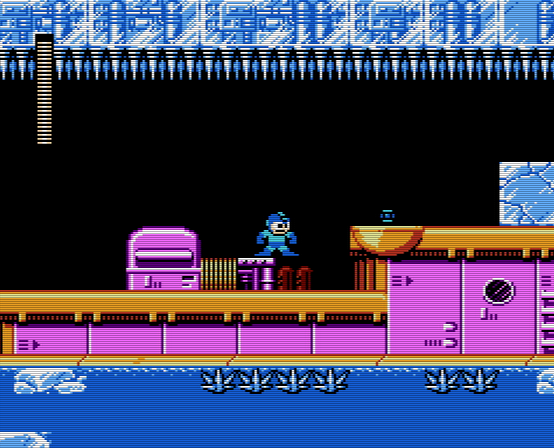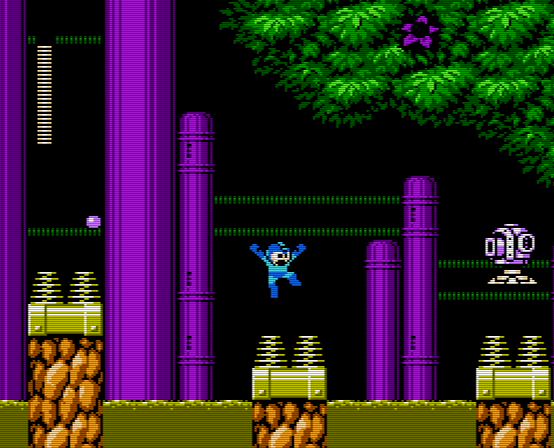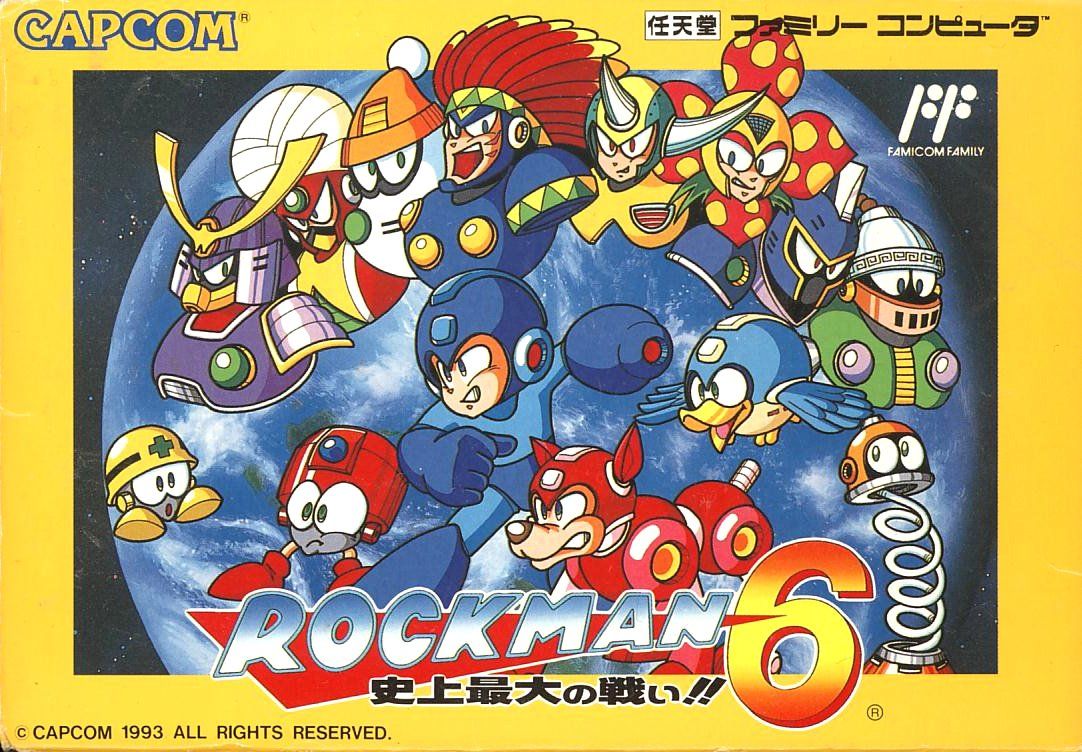Mega Man 6
Success Through Iteration
What makes Mega Man 6 a successful capstone to the NES lineup stems less from the culmination of each individual part, but more about its emblematic symbol of iteration and micro-adds to the formula. Jet and Power Adapter aren’t that different from the gadgets that came before, but the smallest of wrinkles - Jet only having buster pellets yet allowing for periodic adjustments of air time even during freefalls, Power doing trades via fast but light projectiles or strong but short ones when charged - factors majorly when it comes to managing and debating between which of the three Mega forms to use during traversal. Coupled with both unlocking secrets and alternate routes through blatant signposting or quick adjustments, it spruces up the ‘idea’ without changing the fundamentals, thereby uprooting the mechanical fatigue that would seep this deep in.
6, through this philosophy, densifies the vertical/horizontal field of play. Not that it actively has more by default, but it twists this conceit unto specific nudges that were merely dabbled prior. The globe-trotting backdrop heightens the stage design, each locale basing on a specific part of the world doing double-duty as both the Robot Master’s created origin, as well as how that stage’s affinities within are now influenced under different circumstances. From the Arabian temple dabbled with oil that can spark flames, the Atlantis-like setting playing with the idea of water physics adjusting your heights and - my favorite examples - the thick forests Plant Man resides in eschewing standard platforms for a spring juggle where even enemies become involved, and the Western frontier housing such beautiful vistas within and outside its internal structures, telling a story through its environments about the progress of nature to mechanical (this, in turn, also influencing enemy behavior and placements). Enemies are more proactive in halting or even helping your progress, stage elements affect the field and how you operate within it more often, and per usual, each of the weapons have specific quirks that intuit remembrance and niche recognition, and bosses that make full use of the playing field, particularly Wall Walker, Blizzard Man (even if its weapon ends up being lackluster), Flame Man, and the Dino… who ends up having one of the funnier cheese strats yet.
 A submarine in Blizzard Man’s stage bobs up and down, during the player’s navigation of the vehicle. During this, there’s care needed to dodge the spikes atop or below, as well as a few enemies on the roof.
A submarine in Blizzard Man’s stage bobs up and down, during the player’s navigation of the vehicle. During this, there’s care needed to dodge the spikes atop or below, as well as a few enemies on the roof.
These, in turn, re-emphasize the weapon roster’s focal point on distance and use case, especially since most of the ones in 6 edge closer to latitudinal affairs. What I’m about to say crosses into the “no shit Sherlock” line, but the latter end of the NES’ entries excluding 5 makes sure to behold to these two height/distance twists I mentioned prior. Aside from the Buster and the aforementioned Adapters, there’s Flame Blast’s low-slung arc leaving behind a residual flame in quick fashion, Wind Storm’s grounded nature with multi-shot allowance to clear up any oncoming traffic, and Yamato Spear’s piercing shots on shielded enemies, all of which activate distinctly from each other despite covering the same. Even the longitudinal-primed ones have a bit of that instilled, such as Silver Tomahawk doing inch-steps after each fire while it rapidly ascends, Knight Crush’s boomerang arc having a tight oval loop in all three shot variations, and Blizzard Attack’s four-pronged V-shape still travelling in that side direction. With Plant Barrier dabbling in a protection niche and Centaur Flash being a screen nuke, every weapon has a response to these hori/verti scenarios, embellishing these micro-reactions on stage hazards. I solemnly ever drain the whole roster out from their uses throughout the Classic line, but I managed to do that rather consistently by the time I had them all on me.
 Ending Plant Man’s stage is a section of spring jumps the player needs to make, all the while dodging enemy fire. If they have any weapons, these can add on to the decision making to clear the obstacles faster, and even obtain energy pellets symbolized as the flower’s petal.
Ending Plant Man’s stage is a section of spring jumps the player needs to make, all the while dodging enemy fire. If they have any weapons, these can add on to the decision making to clear the obstacles faster, and even obtain energy pellets symbolized as the flower’s petal.
Heck, I don’t have a critique to say about this arsenal period; any quibbles I do have are counterbalanced by a tweaked alleviation (Wind Storm and Centaur Flash also don’t drop items after defeating enemies, but the former takes less energy to use compared to similar types from before, and Flash at least deals decent damage and has a reasonable depletion use to consider using over the others). I was even gonna do a spiel about my disappointment of Blizzard Attack’s damage outputting a meekish performance, until I noticed Hexacryst’s video, itself expanding from their Reddit post doing far more than I had ever bothered to dabble in1, which in turn led me to discover its punishing blows on the floor/ceiling crawling buggers.
There’s a couple of snags that feel like oversight from what’s supposed to happen. I mentioned alternate routes, but more often than not these end up becoming “safe” zones that have minimal encounters. These are fine, rewarding even, but there’s a few instances where it feels as if there were supposed to be active skirmishes instead of a goodie bag. This, in turn, is where the Adapters become a crutch rather than a notch in Rock’s tool - sure, Rush had a tendency to bypass various encounters, but this time there’s at least once guaranteed ignores for a few stages, which fuzzes and cheapens the point of the run-n-gun nature this series is known for. To some degree, it also feels like the developing team caught wind, since this is one of very few times you can’t cheese the Disappearing Block puzzle with a Jet. Doesn’t help that the steam lessenes once you close in on Wily, where each stage becomes shorter and shorter in length even when propped against the prior Castles. Feels weird that the encirclement as to what makes this series so addicting stumbles right when it reaches its marks, but that’s an unfortunate failing Capcom majors seem to suffer from. Also, while not nearly to the same degree, there’s still a nagging feeling someone at the dev team wanted to keep decreasing the challenge factor, since once again it feels like Energy Tanks and Lives sort of feel handed off onto you - granted, it’s not nearly to the same degree as 5 or especially World 2, since A) the arbitrariness of the drop rates aren’t heavily skewed towards your favor, and B) most of these are on paths you have to actively work towards or even unlock through Adapters. Despite Capcom’s continuation of finish line stumbles, it feels wrong to express these minor umbrages, when so much of the package is firing on all cylinders with effortless panache. For a title that hit store shelves just a mere _month_ prior to Rockman X’s debut, it should be taken as an achievement that something this good came out when everyone was looking towards the future.
This goes in hand with an under-discussed topic within the series, or at least its earlier foray: enemies also have varying damage intake depending on the weapon used on them2. Knowledge Base and Fandom wikis have a hit chart available for each game’s enemy, so I recommend giving them a look if there’s been a specific one bugging you. Goes to show how important experimenting these weapons are! ↩︎
Or in some cases, outright break parts of the scripting of their patterns. ↩︎
